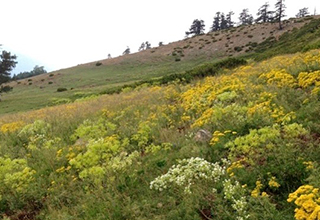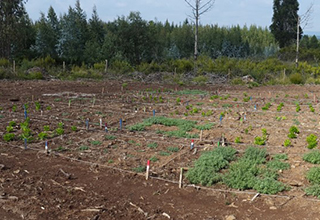AGRONICKEL
Developing Ni agromining on ultramafic land in Europe (Agronickel)
BACKGROUND
European ultramafic soils are rather unfertile, although sometimes still used by agriculture (e.g. Albania), and contain high concentrations of metals and deficiency of nutrient (N, P and K). They cover several thousands of km2 across Europe. As a nature-based solution (NBS), the idea of phytomining metals emerged in the 90s and the goal was to cultivate plants able to accumulate trace metals from metal-rich soils and transport them to the shoots (>1%), which could then be harvested as a bio-ore to recover highly valuable metals, e.g. nickel (Ni).
More recently, the concept has evolved as an integrated chain from soil management to production of bio-sourced refined metal products, i.e. agromining. Several start-up companies are about to commercially develop Ni agromining and a strong research effort is needed to develop a more sustainable chain of production based on the principles of agro-ecology and circular economy. can offer an eco-efficient alternative to classical pyro- or hydrometallurgical processes, as well as providing biomass for local energy production.
OBJECTIVE
The research project aims to implement agroecosystems which can lead to better soil resource efficiency and to offer a fully integrated, new agromining agriculture that could cover thousands of km2 in Europe and benefit local communities with sustainable rural development.
The project has identified, and aims to overcome, the bottlenecks that need to be solved before agromining fully develops in Europe. Traditional agronomy has already been developed for the Ni-hyperaccumulator Alyssum murale but further steps need to be taken in the move towards a more resource-friendly agriculture. This include the evaluation of all potential crops among Ni-hyperaccumulators, long-term effect on soil fertility and biota, optimisation of ecosystem services, optimisation of energy and metal recovery and finally, the re-use of the by-products of the different stages of metal recovery.
METHODOLOGY
Botanical biogeochemical and ecological exporation of ultramafic sites, Transdisciplinary research for agronomy from pot experiments to field trials (European network of agronomic trials) Ecological evaluation and assessement, Evaluation of Ecosystem Services, Life Cycle Assessment Dissemination and Transfer of Technology thanks to the LIFE AGROMINE project.
RESULTS AND KEY FINDINGS
- New species/taxa have been elucidated in the Balkans. The hyperaccumulating Brassicaceae that can be of interest for agromining are tetraploid species (e.g. Odontarrhena chalcidica, Bornmuellera emarginata, B. tymphaea)
- Nickel availability in ultramafic soils seems to trigger the potential agromining yield. When it is non limiting, the best fertilisation pattern is organic manure (vs. NPK). Density, harvesting pattern have been optimised.
- Inoculation of plants with PGPR can improve plant growth and Ni uptake by a significant factor but the associations are to be created with locally adapted bacteria.
- Co-cropping with legumes can result in a significant yield improvement, although some hyperaccumulator suffer from competition with co-cropped plants.
- Yields of 150–200 kg Ni ha-1 per year can now be obtained. The energy recovery yield of ground biomass is compatible with EU regulations and the by products generated by ash washing have characteristics that are compatible with EU regulations on fertilisers (K fertiliser).
- Effects of newly implemented practices (organic fertilisation, co-cropping) have a strong positive effect on soil biological fertility (including soil structure and enzyme functions) and biodiversity.
- Some Ecosystem Services such as Pollination Activity are clearly enhanced whereas the honey produced does not seem to present toxicological risks for consumers.
- These new agro-ecological practices will be assessed with LCA by comparing with conventional agromining already described (Rodrigues et al., 2016)
KEY PUBLICATIONS
- Cecchi et al. (2018) The genus Odontarrhena (Brassicaceae) in Albania: Taxonomy and Nickel accumulation in a critical group of metallophytes from a major serpentine hot-spot. Phytotaxa 351(1):1–28doi:10.11646/phytotaxa.351.1.1
- Kidd et al. (2018) Developing sustainable agromining systems in agricultural ultramafic soils for nickel recovery. Frontiers in Environmental Science 6:44doi: 10.3389/fenvs.2018.00044
- Saad et al. (2018) Influence of new agromining cropping systems on soil bacterial diversity and the physico-chemical characteristics of an ultramafic soil. The Science of the Total Environment 645:380–392doi:10.1016/j. scitotenv.2018.07.106


Coordinator:
Prof. Guillaume Echevarria,
University of Lorraine, France
Email: Guillaume.Echevarria@univ-lorraine.fr
Project period: 02/2016 - 01/2019
Project partners:
CSIC, Spain
University of Natural Resources and Life Sciences Vienna, Austria
CNRS, France
Jagiellonian University, Poland
Agricultural University of Tirana, Albania
Università di Firenze, Italy
Eastern Macedonia and Thrace Institute of Technology, Greece
MICROHUMUS, France.
Total funding: 589.000 €